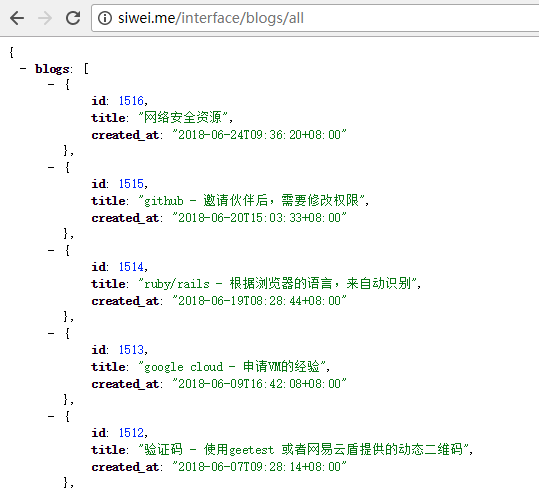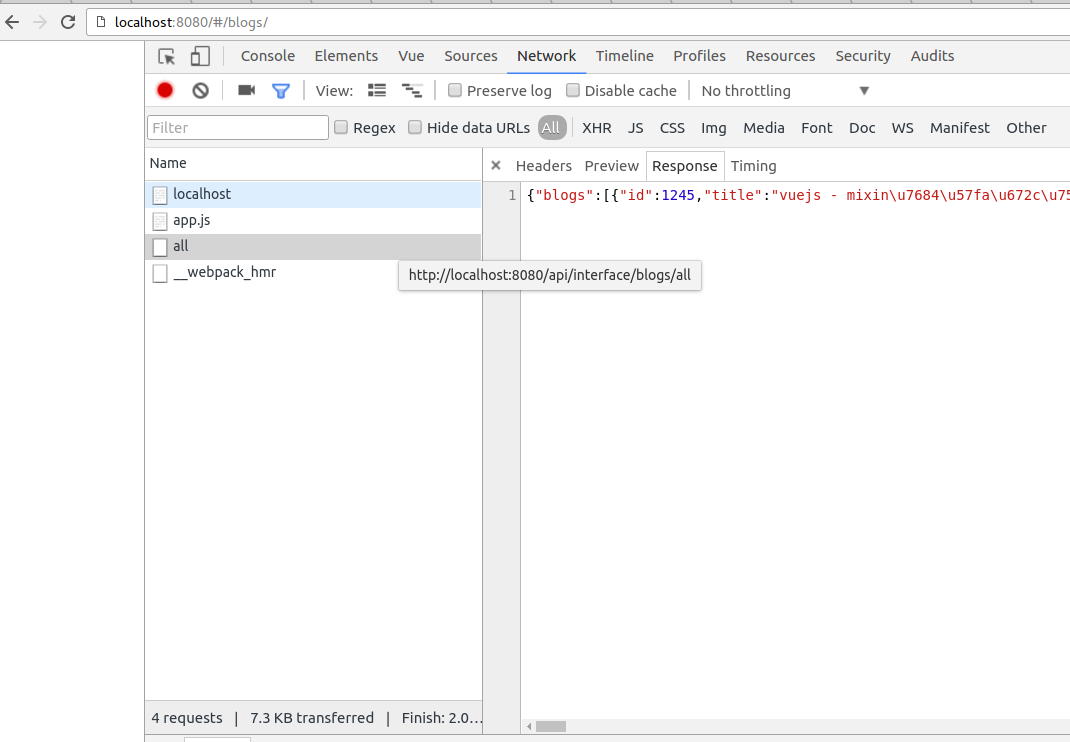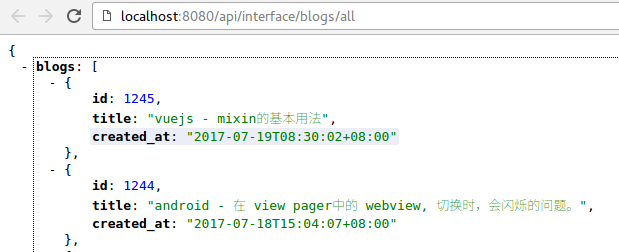- 发送http请求
- 1. 调用http请求
- 2. 远程接口的格式
- 3. 设置 Vuejs 开发服务器的代理
- 4. 打开页面,查看http请求
- 5. 把结果渲染到页面中.
- 如何发起post请求?
发送http请求
TODO: 需要加上 http resource, 在 main.js。
只要有js的地方,就要有接口。 特别是我们这样前后端分离的SPA, 几乎每个页面都要发起http请求。从后台接口读取数据,并且显示在前台页面。
这就需要用到http请求了.
1. 调用http请求
vuejs 内置了对发送http请求的支持. 只需要在对应页面的script 标签内加上对应的代码就好.例如:
我们新增一个页面,叫 “博客列表页” : src/components/BlogList.vue, 它的作用是从我的个人网站(http://siwei.me) 上,读取文章的标题,并且显示出来。
代码如下:
<template><div ><table><tr v-for="blog in blogs"><td>{{blog.title }}</td></tr></table></div></template><script>export default {data () {return {title: '博客列表页',blogs: []}},mounted() {this.$http.get('api/interface/blogs/all').then((response) => {console.info(response.body)this.blogs = response.body.blogs}, (response) => {console.error(response)});}}</script><style >td {border-bottom: 1px solid grey;}</style>
上面的代码中, 我们先看 <script/>代码段,
export default {data () {return {title: '博客列表页',blogs: []}},mounted() {this.$http.get('api/interface/blogs/all').then((response) => {console.info(response.body)this.blogs = response.body.blogs}, (response) => {console.error(response)});}}
上面代码中,先是定义了两个变量: title, blogs, 然后定义了一个 mounted 方法。该方法表示当页面加载完毕后应该做哪些事情。是一个钩子方法。
this.$http.get('api/interface/blogs/all').then((response) => {console.info(response.body)this.blogs = response.body.blogs}, (response) => {console.error(response)});
上面代码,是发起http请求的核心代码。 访问的接口地址是 api/interface/blogs/all , 然后使用 then方法做下一步的事情,then方法接受两个函数作为参数,第一个是成功后干嘛,第二个是失败后干嘛。
成功后的代码如下:
this.blogs = response.body.blogs
然后,在对应的视图部分显示:
<tr v-for="blog in blogs"><td>{{blog.title }}</td></tr>
2. 远程接口的格式
在我的服务器上,读取个人博客标题的接口我已经提前做好了,是 :
http://siwei.me/interface/blogs/all
内容如下;
{blogs: [{id: 1516,title: "网络安全资源",created_at: "2018-06-24T09:36:20+08:00"},{id: 1515,title: "github - 邀请伙伴后,需要修改权限",created_at: "2018-06-20T15:03:33+08:00"},{id: 1514,title: "ruby/rails - 根据浏览器的语言,来自动识别",created_at: "2018-06-19T08:28:44+08:00"},{id: 1513,title: "google cloud - 申请VM的经验",created_at: "2018-06-09T16:42:08+08:00"},{id: 1512,title: "验证码 - 使用geetest 或者网易云盾提供的动态二维码",created_at: "2018-06-07T09:28:14+08:00"}// 更多内容。。。]}
在浏览器中打开后,如下图所示(使用了 jsonview 插件做了json 的代码格式化):

3. 设置 Vuejs 开发服务器的代理
正常来说, javascript在浏览器中是无法发送跨域请求的,所以我们需要在vuejs的"开发服务器"上做个转发配置.
修改: config/index.js文件,增加下列内容:
module.exports = {dev: {proxyTable: {'/api': { // 1. 对于所有以 "/api" 开头的url 做处理.target: 'http://siwei.me', // 3. 转发到 siwei.me 上.changeOrigin: true,pathRewrite: {'^/api': '' // 2. 把url中的 "/api" 去掉.}}},}
上面的代码做了三件事:
- 对于所有以 “/api” 开头的url 做处理.
- 把url中的 “/api” 去掉.
- 把新的url 请求打到 siwei.me 上.
例如:
- 原请求: http://localhost:8080/api/interface/blogs/all
- 新请求: http://siwei.me/interface/blogs/all
注意: 以上的代理服务器内容,只能在"开发模式"下才能使用.在生产模式下,只能靠服务器的nginx的特性来解决js跨域问题.
修改后的 config/index.js文件的完整内容如下:
var path = require('path')module.exports = {build: {env: require('./prod.env'),index: path.resolve(__dirname, '../dist/index.html'),assetsRoot: path.resolve(__dirname, '../dist'),assetsSubDirectory: 'static',assetsPublicPath: '/',productionSourceMap: true,productionGzip: false,productionGzipExtensions: ['js', 'css'],bundleAnalyzerReport: process.env.npm_config_report},dev: {env: require('./dev.env'),port: 8080,autoOpenBrowser: true,assetsSubDirectory: 'static',assetsPublicPath: '/',proxyTable: {'/api': {target: 'http://siwei.me',changeOrigin: true,pathRewrite: {'^/api': ''}}},cssSourceMap: false}}
重启服务器,可以看到我们的转发设置已经生效:
$ npm run dev...[HPM] Proxy created: /api -> http://siwei.me[HPM] Proxy rewrite rule created: "^/api" ~> ""> Starting dev server......
4. 打开页面,查看http请求
我们接下来,访问 http://localhost:8080/#/blogs/
打开chrome developer tools, 就可以看到,”Network”中,已经有请求发出去了,截图显示了结果:

另外,我们也可以直接在浏览器中,输入要打开的链接,看到结果.(该浏览器使用了 json view插件)

5. 把结果渲染到页面中.
我们发现,在export代码段中,有两个部分:
<script>export default {data () { },mounted() { }}</script>
实际上,上面代码中,
data方法,是用于"声明页面会出现的变量",并且赋予初识值.(非常重要,切记这一点)mounted表示页面被vue渲染好之后的钩子方法,会立刻执行.
所以,我们要把发送http的请求,写到mounted方法中.(钩子方法还有created, 我们可以暂且认为mounted方法与created方法基本一样,一般我们在Vue 2.0中都使用mounted. 后续会说到区别. )
mounted() {this.$http.get('api/interface/blogs/all').then((response) => {this.blogs = response.body.blogs}, (response) => {console.error(response)});}
上面代码中:
this.$http中的this表示当前的vue组件(也即 BookList.vue)$http所有以$开头的变量,都是vue的特殊变量,往往是vue框架自带. 这里的$http就是可以发起http请求的对象.$http.get是一个方法,可以发起get 请求. 只有一个参数就是目标url,then()方法,来自于promise, 可以把异步的请求写成普通的非异步形式.第1个参数是成功后的callback,第2个参数是失败后的callback.this.blogs = response.body.blogs中,是把远程返回的结果(json ),赋予到本地. 由于javascript的语言特性,能直接支持json ,所以才可以这样写.
然后,我们通过这个代码进行渲染:
<tr v-for="blog in blogs"><td>{{blog.title }}</td></tr>
在上面的代码中:
v-for是一个循环语法,可以把这个元素进行循环. 注意:这个叫directive, 指令,需要跟标签一起使用.blog in blogs: 前面的blog是一个临时变量,用于遍历使用.
后面的blogs 是http 请求成功后, this.blogs = ... 这个变量.
同时,这个this.blogs 是声明于 data钩子方法中.
- {{blog.title}} 用来显示每个blog.title的值
如何发起post请求?
跟get特别类似,就是第二个参数是 请求的body.
在 vue的配置文件中 (例如 webpack项目的 src/main.js 中)增加下面一句:
import VueResource from 'vue-resource';Vue.use(VueResource);....//增加下面这句:Vue.http.options.emulateJSON = true;
上面这句的目的,是为了能够让发出的post请求不会被浏览器转换成option 请求.
然后就可以按照下面的代码发送请求了:
this.$http.post('api/interface/blogs/all', {title: '', blog_body: ''}).then((response) => {...}, (response) => {...});
在本书的 《表单的提交》 章节中,会对 http POST 的发送有个实际的例子,看起来会更加明白。
关于发送http请求的更多内容,请看: 官方文档:https://github.com/pagekit/vue-resource
